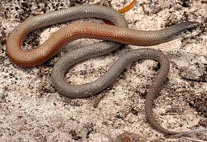Abstract
The Australian pygopodid lizard genus Delma is characterised by morphologically conservative but genetically divergent lineages and species. An initial assessment of molecular and morphological variation in Delma australis Kluge, 1974 throughout its main distribution in Western and South Australia reveals at least two undescribed species that are presently included under this epithet. Here we describe the most distinctive and easily diagnosed taxon of these, D. hebesa sp. nov., from the proteaceous scrub and mallee heath on the south coast sandplains of southwestern Western Australia. We also foreshadow the need for an expanded genetic framework to assist in unequivocally diagnosing additional candidate species in D. australis, which is redescribed herein and shown to be monophyletic for those specimens sampled, albeit displaying geographic variation in a range of molecular and morphological characters. Delma hebesa sp. nov. differs from all other described Delma species, including regional populations of D. australis, by a combination of molecular genetic markers, colouration and scalation. Based on phylogenetic affinities and shared morphologies, a D. australis species-group is proposed to accommodate D. australis, D. torquata and the new species described herein. The addition of another new vertebrate species from southwestern Western Australia, recognised globally as a biodiversity ‘hotspot’, underlines our lack of understanding of genetic diversity and evolutionary histories in this biodiverse region.

